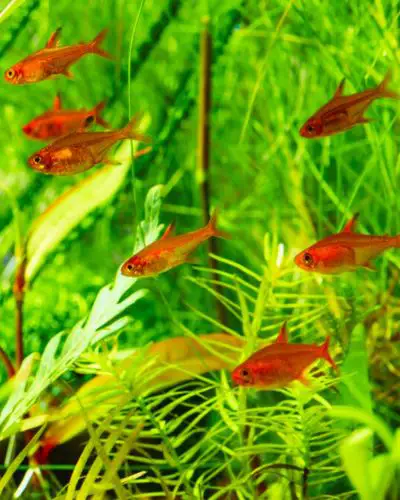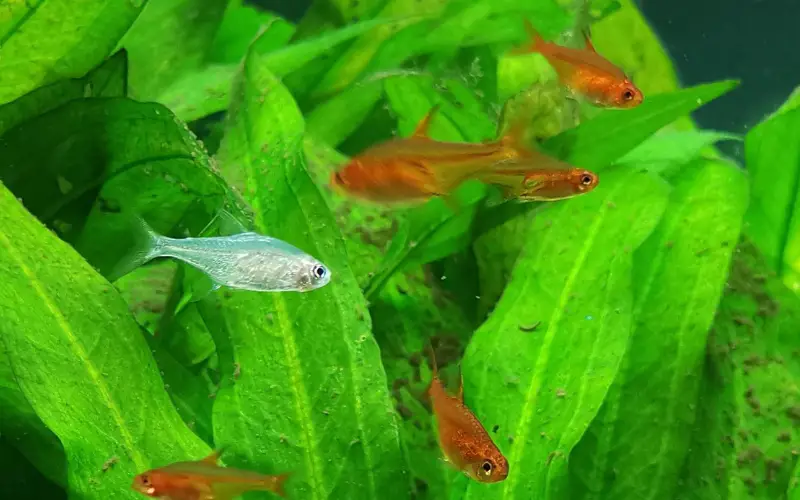So, you’ve been bitten by the breeding bug! There’s something magical about witnessing the circle of life unfold in your aquarium, and Ember Tetras, with their fiery hues, are a fantastic choice. But let’s be honest; seeing those tiny Ember Tetra eggs scattered amongst the plants is only half the battle.
Ember Tetras are popular freshwater aquarium fish known for their vibrant red and orange colors.
Breeding Ember Tetras can be a rewarding experience for fishkeepers, but achieving a high hatch rate for the ember tetra fish eggs can be challenging.

Are you getting them to hatch? That can feel like a whole other level of aquarist wizardry! Don’t worry; you don’t need a magic wand for this one. Maximizing your hatch rate boils down to just three simple steps.
This article will share three steps to ensure you get the maximum hatch rate for Ember Tetra eggs in your aquarium. From setting up the breeding tank to providing the right conditions for the eggs to hatch, we will guide you through the process.
Before you know it, these easy-to-follow actions will welcome a whole school of miniature embers into your tank. Intrigued? Keep reading – your future fry are depending on it!
Table of Contents
ToggleDo Ember Tetras Lay Eggs?
Ember Tetras are known as egg-laying fish, meaning they lay their eggs and then proceed to eat them. In a community tank, it can be challenging for these adult fish to protect their offspring from being eaten by other tankmates, such as shrimp or larger fish.
If you are a breeder hoping to see Ember Tetra fry, you may need to set up a separate breeding tank to ensure the survival of the juvenile fish.

Some hobbyists have reported success raising Ember Tetra fry by feeding them baby brine shrimp and infusoria. These tiny fish require a heavily planted tank with safe hiding spots for the juvenile fish to grow.
As I’ve seen in a YouTube video, Ember Tetras can be egg scatterers, much like the Black Neon Tetra. The transparent eggs will hatch after a few days, and the fry from the egg batch will swim near the bottom of the tank.
In the video description, the breeder mentioned that they like to get Ember Tetra to fry to feed on baby brine shrimp for optimal growth. To increase the chances of survival, some hobbyists have even used a plastic craft mesh to separate the fry from the parents or other tankmates.
What Do Ember Tetra Eggs Look Like?
Ember tetra eggs are tiny and translucent, resembling small pearls. The parental care pair usually lays them on plants or other surfaces in the tank. These fish breeding enthusiasts are lucky to witness when the eggs to fall from the glass and hatch into fry from egg.
The cute little fry swims around the tank looking for food; providing them with powder or finely crushed food is essential. A well-established colony of ember tetras will continue to spawn and produce more eggs in a mature tank with stable pH levels and a good filter system.
Some aquarists may even have the opportunity to see fry from eggs of other species, like Corydoras or Danios. Tetra fish breeding is a rewarding hobby that provides a glimpse into the fascinating world of live fish production.
Those lucky enough to ship live fish to other enthusiasts can subscribe to a new level of excitement in the aquarium world. It’s always a joy to witness the moss-like fry colony growing more vibrant each day.
How to Breed Ember Tetras: (3 EASY Steps For SUCCESS!)
Breeding Ember Tetras can be a rewarding experience for hobbyists. Here’s a breakdown of the process in 3 easy steps:
1. Setting Up the Breeding Tank:
- Tank Size: A small, mature tank of around 10 gallons is ideal.
- Water Conditions: Aim for slightly acidic soft water with a stable temperature higher than usual (around 78°F).
- Habitat: Provide the eggs with a spawning medium like Java moss or spawning mops. A bare bottom or fine gravel substrate works well.
- Conditioning the Breeders: Separate a healthy group of Ember Tetras (ratio of 3-4 females to 1 male) into this tank and feed them high-protein foods like brine shrimp or bloodworms to encourage breeding.
2. Stimulating Spawning:
- Water Changes: Simulate a rainy season with small, frequent water changes using cooler water (within a safe range for the fish).
- Lighting: Slightly increase the light duration to mimic longer daylight hours.
3. Egg Care and Raising Fry:
- Removing Adults: Once spawning is observed (usually in the morning), remove the adult Ember Tetras. They will eat their own eggs.
- Eggs and Fry: The tiny, transparent ember tetra fish eggs will hatch in a few days. Infusoria, vinegar eels, or powdered fry food are ideal for feeding the fry. Maintain pristine water quality with small daily water changes.
Bonus Tip: Ember Tetras are egg scatterers and offer no parental care. You can use an egg trap (a mesh breeder filled with spawning moss) to collect the eggs after spawning and raise them separately for better survival rates.
Remember, research is vital. For more details on water parameters, tank setups, and troubleshooting, consider consulting online resources or experienced aquarists.
How to Set Up an Aquarium for Ember Tetra Breeding
To set up a suitable environment for them, start by choosing a tank that is at least Nano sized. They are small fish that do best in a small community.
Next, add live plants and hiding spots for them to feel secure. Maintaining a stable water temperature and keeping the water clean and well-filtered is also essential. Ember Tetras are peaceful fish that do well with other peaceful species like hatchetfish and gouramis.
Be cautious if keeping them with bigger fish like cichlids or aggressive species. Finally, they should be fed various foods and be mindful of their breeding habits. Ember Tetras scatter their eggs, so providing moss or a spawning channel can help prevent them from falling prey to other tank mates like snails.
Caring for Baby Ember Tetra Tips
Caring for baby Ember Tetra can be a rewarding experience, but it requires attention to detail and patience. One important tip is to ensure you provide them with a thick layer of plants in their tank to mimic their natural habitat.
This will give them places to hide and feel secure, which is critical to their well-being. Keep the water temperature stable and clean, as they are sensitive to changes in water quality.
Additionally, be mindful of their diet and feed them small, frequent meals to ensure they are getting the nutrients they need to grow and thrive. It’s also helpful to observe their behavior and make adjustments as needed.
Remember to comment on forums or seek advice from experienced fishkeepers who can offer valuable insights and support. For more information, follow this link to a helpful care transcript.
Commonly Asked Questions about Ember Tetra Laying Eggs (FAQs)
Will ember tetras breed in my tank?
Ember tetras might! They’re relatively easy to breed. Please set up a mature tank with hiding spots for fry and condition them with high-protein food.
How do you care for Ember tetra with eggs?
Ember tetras are egg scatterers and don’t care for the young. To save ember tetra fish eggs, remove adults after spawning. Use mesh to block the bottom or add spawning mops to hide eggs.
How many eggs does ember tetra lay?
Ember tetras typically lay between 50-100 eggs. However, the exact number can vary depending on the female’s age and health.
How often do ember tetras reproduce?
In ideal aquarium conditions, ember tetras can spawn regularly, with some breeders reporting successful breeding every few weeks. However, specific frequency depends on water quality, diet, and breeding setup.
Are ember tetra eggs sticky?
No, ember tetras eggs are not sticky. They are free-floating and scatter throughout the tank, making them vulnerable to being eaten by other fish.
How do you hatch a tetra egg?
Isolate eggs in a dark, still tank with soft water. Remove adult tetras, as they might eat the eggs. Hatchlings appear in 24 hours and need infusoria or fry food.
How do you tell male from female ember tetra?
Telling male from female ember tetras is tricky. Look for a rounder belly in females, especially from above. Males are typically slimmer.
How do ember tetras lay eggs?
The female releases eggs in the tank, and the male fertilizes them as they fall. These tetras don’t care for their eggs, so they need dense plants for hiding.
Do tetras eat their eggs?
Yes, tetras often eat their own eggs. They are egg scatterers and don’t exhibit parental care. To save your tetra fry, remove the adults after spawning.
Conclusion
Breeding Ember Tetras is a rewarding experience, bringing a burst of new life and vibrant color to your aquarium. Remember, the success of hatching these tiny creatures lies not in complicated procedures but in understanding their basic needs. Providing a stress-free environment with pristine water conditions and ample hiding spots for both parents and fry are the cornerstones of successful breeding.
Keep going even if your first attempt doesn’t yield a tank brimming with fry. Breeding is a learning process, and every experience brings you closer to mastering the art of nurturing these fiery beauties. With each batch of ember tetra fish eggs, you’ll gain valuable insights and refine your approach, leading to more successful hatches. So go ahead, try these steps, and witness the magic of new life unfold.
With a bit of patience and the right approach, you’ll soon be surrounded by a flurry of tiny, shimmering fish, proving that hatching those ember tetra eggs isn’t just easy; it’s gratifying!
Recommended posts
- Ember Tetras Fish Size 101: A Beginner’s Guide to Aquatic Success
- Ideal Ember Tetra Temperature Range (Beginner’s Advice)
- Ember Tetra Breeding Behavior: The ULTIMATE Beginners Guide
- Will Neons and Ember Tetras School or Clash: (Expert Advice)
- The Exact Tetra Neon Eggs Hatching Time: (Witness the Magic)
- How to Tell If Ember Tetra Is Pregnant: 5 SHOCKING Signs Can’t Ignore!





